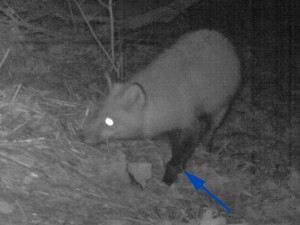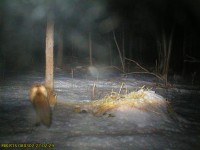Order: Carnivora, Family: Canidae
Appearance/Behavior: This fox (68 – 82 cm) is primarily rusty red, with black on the leg fronts (blue arrow), ears, and upper and lower fringe of the bushy tail. The chin (red arrow), underside and tail tip all show white. Red fox encounters typically involve one individual at a time.
Relative Frequency of Visitation in Study: Occasional visitors.
Seasonal Activity: Year-round.
Daily Activity: Primarily nocturnal.
Similar Species: Distinguishing between the red and gray fox can be challenging at first, but becomes easier with practice. The best approach is to spend time studying the various sample images provided for these two species, focusing on the characteristics mentioned below. The red fox, on average, is somewhat smaller than the gray fox. The head of a red fox has a rusty red forehead and cheeks, with black along the back of the ears, while the head of the gray fox has a gray forehead and cheeks, with orange extending up from the neck to the backs of the ears. Both species have a white chin and some black around the muzzle. Most fox visits are at night, resulting in grayscale images (due to infrared illumination). In such images, the black feet and shins of the red fox are distinctive compared to their orange counterparts in the gray fox. A lateral view should show a flank of uniform color in the red fox and a darker gray upper band and lighter orange lower band in the gray fox. Furthermore, in a grayscale image, the dark upper edge of the tail is much more pronounced in the gray fox as it extends from the back. Also the tail tip of the gray fox has a wide black band that is lacking in the red fox in which the tail tip will often show white fur.
Well-defined Images:
Challenging Images:
Help with challenging images: Rows 1-2, Rows 3-4
Near Video:


























